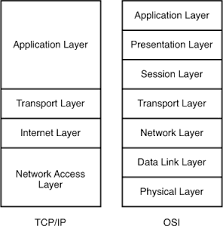The OSI (Open System Interconnection) model and TCP/IP (Transmission Control Protocol/Internet Protocol) model are two different approaches to understanding and describing how communication happens between computers and networks.
The OSI model is a conceptual framework that describes how data travels from a source to a destination by breaking down the process into seven distinct layers, each with a specific function.
The TCP/IP model, on the other hand, provides a more practical and functional view of how communication happens on the Internet. It is a four-layer model, which describes the processes of network communication in a more simplified and straightforward manner compared to the OSI model.
In summary, the OSI model is a more theoretical approach to understanding the process of communication, while the TCP/IP model is more practical and focused on how communication actually occurs on the Internet.
As you can see below the two models align slightly differently but there are some comparative levels. The top 3 layers of the OSI mode are summarised by the one "Application" layer in the OSI model. The transport layer is also matched in both models. Some common ways of remembering the models are;
For TCP/IP I use A TIN
For OSI I use All People Seem To Like Data Processing
But what does it all mean and why is it important? Well if you imagine two OSI models stacked side by side, one with a PC on the top (the user) the other a server. When a user goes on a web page they are accessing an Application, the data then is compressed or encrypted (Presentation), A session is then created between two end to end applications for managing communication in either full or half duplex mode (send and receive simultaneously or send and wait to receive), The transport layer manages how data is sent, is it in a sequenced order or all at once, the network layer is where routing processes take place through IP addressing and the data link layer is where physical addressing is assigned ie Mac addresses and finally the physical layer is the network medium ie bits processed across wireless transmission or wired.





No comments:
Post a Comment